by Bruce Wells | Jul 28, 2025 | This Week in Petroleum History
July 28, 1924 – Oil Scouts form National Group –
The National Oil Scouts Association of America, later the International Oil Scouts Association (IOSA), filed its charter in Austin, Texas, bringing new standards to an important oilfield profession. Since the 1860s, oilfield scouts have gathered field intelligence on drilling operations, including often sensitive information about the operator, well location and lease details — anything that may yield a competitive advantage. These “night riders of the hemlocks” also sleuth drilling depths, geologic formations encountered, logs, and other data.
Learn more in Oil Scouts – Oil Patch Detectives.
July 28, 1953 – Final Oilfield Patent for Zero Hour Bomb Company
Manufacturer of oilfield products since 1932, the Zero Hour Bomb Company of Tulsa, Oklahoma, received its last U.S. patent relating to electric timer explosives for fracturing geologic formations. The service company patented its device for positioning blasting cartridges in wells — a “well bridge” that automatically opened, “when the time bomb or weight reached a position at the bottom of the well.”

Oilfield service provider Zero Hour Bomb Company was founded in Tulsa, Oklahoma, in 1932. Photos courtesy Zebco.
The downhole apparatus was never built, because company executives already were manufacturing and marketing a new, “cannot backlash” fishing reel invented by Jasper “R.D.” Hull, who they had hired in 1947. Zero Hour Bomb Company changed its name to Zebco in 1956.
Learn more in Zebco Reel Oilfield History.
July 28, 1977 – Trans-Alaska Pipeline delivers Oil to Port of Valdez
The first barrel of oil from the North Slope’s Prudhoe Bay oilfield arrived at the Port of Valdez after an 800-mile journey through the Trans-Alaska Pipeline System.

The Trans-Alaska Pipeline delivered North Slope oil almost a decade after the Prudhoe Bay field’s discovery. OMAR refers to the Organization for Management of Alaska’s Resources, now the Resource Development Council for Alaska.
At peak flow in 1988, 11 pumping stations moved 2.1 million barrels of oil a day. The 48-inch-wide pipeline has been recognized as a landmark of engineering (see Trans-Alaska Pipeline History).
July 29, 1918 – “World’s Wonder Oil Pool” discovered in Texas
Less than a year after the “Roaring Ranger” discovered an oilfield to the south, the Fowler No. 1 well at the cotton farming community of Burkburnett, Texas, revealed a new giant field at a depth of 1,734 feet. Within three weeks, 56 rigs were drilling near the Fowler Farm Oil Company site along the Red River in North Texas.

Circa 1919 photo captioned, “Burkburnett, Texas, the World’s Wonder Oil Pool,” showing eight months’ phenomenal development, viewed from the northwest side, opposite Fowler farm.” A. Newman Photographic Company photo courtesy Library of Congress.
Fowler’s decision to drill a well on his Wichita County farm had been called “Fowler’s Folly” until his oil discovery brought hundreds of oil companies to the county. By January 1919, Burkburnett’s population reached more than 8,000 people — with a line of derricks two miles long greeting new arrivals.
As the “World’s Wonder Oil Pool” made national headlines, teenager Clark Gable was a 17-year-old roustabout working in Oklahoma. Gable and Spencer Tracy would star in Hollywood’s version of Burkburnett oil history, the popular 1940 movie “Boom Town.”
Learn more in Boom Town Burkburnett.

July 29, 1957 – Eisenhower limits Oil Imports
As America’s reliance on foreign oil continued to grow — discouraging domestic production — President Dwight D. Eisenhower established a Voluntary Oil Import Program with import quotas by region. The intent was to ensure adequate domestic petroleum in case of a national emergency.
Using a presidential proclamation two years later, Eisenhower made the program mandatory. By 1962, oil imports were limited to 12.2 percent of U.S. production. The program continued until suspended by President Richard Nixon in 1973 as domestic oil production reached new highs during the OPEC oil embargo.
July 30, 1942 – U-166 sinks, discovered 60 years later
A Navy patrol boat attacked and sank a German U-boat in the Gulf of Mexico after the submarine had torpedoed a U.S. freighter. Despite being depth-charged, the U-166 was believed to have escaped — until a natural gas pipeline survey revealed it 59 years later.
The U-166’s identity was not learned until advanced geophysical survey technologies arrived in 2001, according to the National Oceanic and Atmospheric Administration (NOAA). The discovery resulted from an archaeological survey prior to construction of a natural gas pipeline by the British company BP and Shell Offshore Inc.
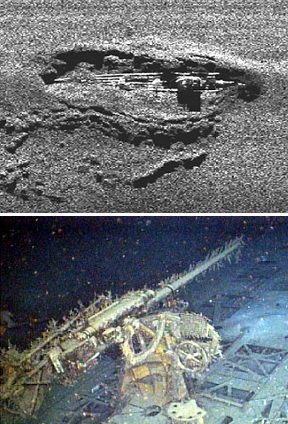
A natural gas pipeline survey revealed the U-166 about 45 miles off the Louisiana coast in 2011.
Remotely operating vehicles (ROVs) and an autonomous side-scan sonar revealed U-166 separated from its last victim, the Robert E. Lee, by less than a mile. BP and Shell altered their proposed pipeline to preserve the site.
With the petroleum industry the principal user of advanced underwater technologies for seafloor mapping, other World War II vessels have been discovered during oil and natural gas surveys.
Learn more in Petroleum Survey discovers U-boat.

August 1, 1872 – Iron Pipeline delivers Pennsylvania Natural Gas
The first large-scale delivery of natural gas by pipeline began when gas was piped to more than 250 residential and commercial customers in Titusville, Pennsylvania, home of America’s first oil well, drilled in 1859. An iron pipeline two inches wide carried the natural gas five miles from a well producing four million cubic feet of gas a day.
Investors, including the mayor of Titusville, had formed the Keystone Gas & Water Company to construct the pipeline and deliver “the most powerful and voluminous gas well on record.” The well produced into the 1880s, according to the Drake Well Museum and Park.
August 2, 1956 – Missouri builds First U.S. Interstate Highway
Missouri became the first state to award a contract with interstate construction funding authorized two months earlier by the Federal-Aid Highway Act. The highway commission agreed to begin work on part of Route 66, now Interstate 44.
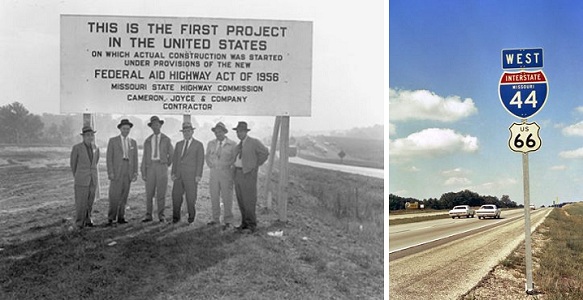
Missouri launched the U.S. interstate system after “inking a deal for work on U.S. Route 66.” Today, I-44 stretches across south central Missouri and is a major corridor linking the Midwest and the West Coast.
“There is no question that the creation of the interstate highway system has been the most significant development in the history of transportation in the United States,” proclaimed the Missouri Department of Transportation (also see America on the Move).
August 3, 1769 – La Brea Asphalt Pits discovered
A Spanish expedition discovered what would be called La Brea (the tar) pits on the West Coast. “We debated whether this substance, which flows melted from underneath the earth, could occasion so many earthquakes,” noted the expedition’s Franciscan friar in his diary.

The Page Museum of Los Angeles offers life-size replicas of extinct mammals at the Rancho La Brea in Hancock Park. Although called the “tar pits,” the pools are asphalt.
The friar, Juan Crespi, was the first person to use the term “bitumen” in describing these sticky pools in southern California — where crude oil has been seeping from the ground through fissures in the coastal plain sediments for more than 40,000 years. Native Americans used the substance for centuries to waterproof baskets and caulk canoes.

Sticky pools form when crude oil seeps to the surface through fissures in the earth’s crust.
Although popularly called the tar pits, the pools at Rancho La Brea are actually asphalt — not tar, which is a by-product made by the distillation of woody materials, such as peat. Asphalt is a naturally formed substance comprised of hydrocarbon molecules (see Asphalt Paves the Way).
Learn more in Discovering the Le Brea Tar Pits.

August 3, 1942 – War brings “Big Inch” and “Little Big Inch” Pipelines
War Emergency Pipelines Inc. began construction on the “Big Inch” line — the longest petroleum pipeline project ever undertaken in the United States. Conceived to supply wartime fuel demands — and in response to U-boat attacks on oil tankers along the eastern seaboard and Gulf of Mexico, the “Big Inch” and “Little Big Inch” lines were extolled as “the most amazing government-industry cooperation ever achieved.”
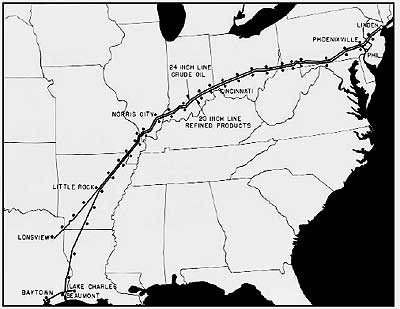
The longest petroleum pipeline project ever undertaken led to construction of a 24-inch pipeline from East Texas to Illinois, and a 20-inch line as far as New York City.
With a goal of transporting 300,000 barrels of oil per day, the $95 million project called for construction of a 24-inch pipeline (Big Inch) from East Texas to Illinois, and a 20-inch line (Little Big Inch) as far as New York and Philadelphia. The pipelines would reach more than 1,200 miles (the Trans-Alaska pipeline system is 800 miles long).
Learn more in Big Inch Pipelines of WWII.
_______________________
Recommended Reading: The Oil Scouts – Reminiscences of the Night Riders of the Hemlocks (1986); Trek of the Oil Finders: A History of Exploration for Petroleum (1975); Amazing Pipeline Stories: How Building the Trans-Alaska Pipeline Transformed Life in America’s Last Frontier
(1986); Trek of the Oil Finders: A History of Exploration for Petroleum (1975); Amazing Pipeline Stories: How Building the Trans-Alaska Pipeline Transformed Life in America’s Last Frontier (1997). Early Texas Oil: A Photographic History, 1866-1936
(1997). Early Texas Oil: A Photographic History, 1866-1936 (2000); Eisenhower: Soldier and President
(2000); Eisenhower: Soldier and President (1968); The Extraction State, A History of Natural Gas in America (2021); Torpedoes in the Gulf: Galveston and the U-Boats, 1942-1943
(1968); The Extraction State, A History of Natural Gas in America (2021); Torpedoes in the Gulf: Galveston and the U-Boats, 1942-1943 (1995). The Big Roads: The Untold Story of the Engineers, Visionaries, and Trailblazers Who Created the American Superhighways
(1995). The Big Roads: The Untold Story of the Engineers, Visionaries, and Trailblazers Who Created the American Superhighways (2012); Monsters Of Old Los Angeles – The Prehistoric Animals Of The La Brea Tar Pits
(2012); Monsters Of Old Los Angeles – The Prehistoric Animals Of The La Brea Tar Pits (2008); Oil: From Prospect to Pipeline
(2008); Oil: From Prospect to Pipeline (1971). Amazon purchases benefit the American Oil & Gas Historical Society. As an Amazon Associate, AOGHS earns a commission from qualifying purchases.
(1971). Amazon purchases benefit the American Oil & Gas Historical Society. As an Amazon Associate, AOGHS earns a commission from qualifying purchases.
_______________________
The American Oil & Gas Historical Society (AOGHS) preserves U.S. petroleum history. Please become an AOGHS annual supporter and help maintain this energy education website and expand historical research. For more information, contact bawells@aoghs.org. Copyright © 2025 Bruce A. Wells. All rights reserved.
by Bruce Wells | Jul 21, 2025 | This Week in Petroleum History
July 21, 1935 – “Diamond Glenn” McCarthy strikes Oil –
Glenn H. McCarthy struck oil 50 miles east of Houston in 1935, extending the already prolific Anahuac field. The well was the first of many for the Texas independent producer who would discover 11 Texas oilfields by 1945.
McCarthy became known as another “King of the Wildcatters” and “Diamond Glenn” by 1950, when his estimated worth reached $200 million ($2 billion today).

TIME magazine in 1950 featured Texas wildcatter Glenn McCarthy of Houston.
In addition to his McCarthy Oil and Gas Company, McCarthy eventually owned a gas company, a chemical company, a radio station, 14 newspapers, a magazine, two banks, and the Shell Building in Houston. In the late 1940s, he invested $21 million to build the 18-story, 1,100-room Shamrock Hotel — and reportedly spent $1 million on its St. Patrick’s Day 1949 opening gala, which newspapers dubbed “Houston’s biggest party.”
Learn more in “Diamond Glenn” McCarthy.
July 22, 1933 – Phillips Petroleum sponsors Flight around the World
Before 50,000 cheering New York City onlookers, former roughneck Wiley Post landed his Lockheed 5C Vega “Winnie Mae,” becoming the first person to fly solo around the world. Post had worked in oilfields near Walters, Oklahoma, when he took his first airplane ride with a barnstormer in 1919 and was inspired to take lessons.
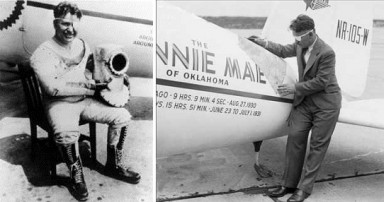
Thanks to a friendship with Frank Phillips, Wiley Post set altitude records and became the first person to fly solo around the world.
In 1926, on the first day of working at a well near Seminole, a metal splinter severely damaged his left eye, causing loss of sight. Post used the $1,700 in compensation to buy his first airplane. He became friends with Frank Phillips, president of Phillips Petroleum, sponsor of several high-altitude experimental flights. Phillips also sponsored the “Woolaroc” — winning plane of an August 1926 air race across the Pacific.

July 22, 1959 – Marker erected for Second U.S. Oil Well
The Pennsylvania Historical and Museum Commission dedicated a state marker to commemorate the man who drilled for oil just a few days after Edwin Drake completed the first U.S. commercial well on August 27, 1859. “After Drake’s discovery of oil in Titusville, some area residents attempted to sink their own well,” noted historians at Explore Pennsylvania. “The vast majority of such efforts failed.”
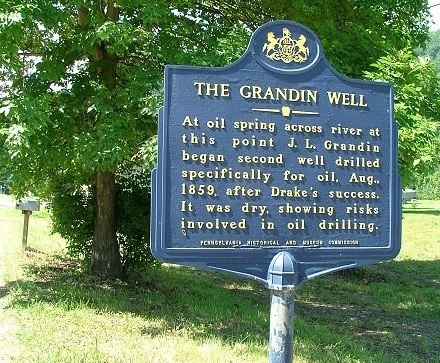
Pennsylvania historical marker for the 1859 Grandin well — America’s second oil well, which was a dry hole.
Using a simple spring pole, 22-year-old John Grandin and a local blacksmith began to “kick down” a well that would reach almost twice as deep as Drake’s cable-tool depth of 69.5 feet. Despite not finding the oil-producing formation (the Venango Sands), Grandin’s well produced several “firsts” for the young U.S. petroleum industry.
Learn more in First Dry Hole.
July 23, 1872 – “Real McCoy” Steam-Engine Lubricator
Using petroleum for improving the performance of locomotives became widespread when Elijah McCoy patented an automatic lubricator for steam engines. McCoy designed a device that applied oil through a drip cup to locomotive and ship steam engines. Instead of stopping engines to apply necessary lubrication, McCoy’s device provided it while they ran, saving railroads time and money.
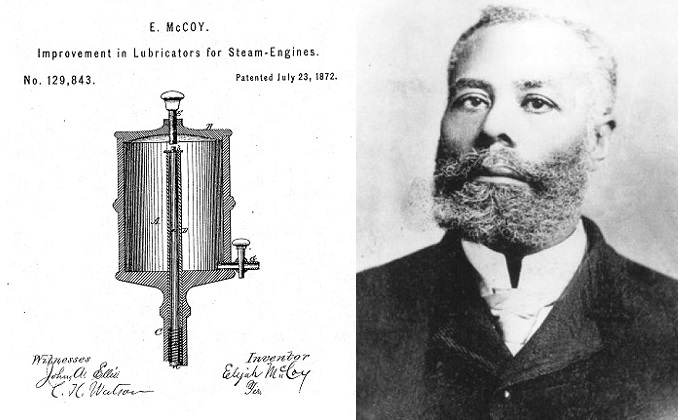
Elijah McCoy invented lubrication systems for steam engines, early beneficiaries of petroleum. Awarded more than 60 patents, he was inducted into the National Inventors Hall of Fame in 2001.
The Canadian-born McCoy was the son of slaves who had escaped Kentucky. After his family settled in Michigan, 15-year-old McCoy traveled to Scotland to study mechanical engineering. By the time he died in 1929, the inventor had received 60 patents, according to a 1994 Michigan historical marker.
The expression “the real McCoy” reportedly came from railroad engineers not wanting to buy low-quality copycats of his popular device. Before purchasing the lubricator, buyers would ask if it was “the real McCoy.”
July 23, 1951 – Desk & Derrick Clubs organize
After a secretary at Humble Oil and Refining Company organized the first club in New Orleans, the Association of Desk & Derrick Clubs (ADDC) of North America officially began with articles of association signed by the presidents of clubs in Jackson, Mississippi, New Orleans, Los Angeles, and Houston. By 1952, representatives from 40 clubs would attend the first ADDC convention, held at Houston’s Shamrock Hotel.
Learn more in Desk and Derrick Educators.

July 24, 2000 – BP unveils New Green and Yellow Logo
BP — the official name of a group of companies including Amoco, ARCO and Castrol — unveiled a new corporate identity brand, replacing the “Green Shield” logo with a green and yellow sunflower pattern.

The company also introduced a new corporate slogan: “Beyond Petroleum.” When BP — then British Petroleum — merged with Amoco in 1998, the company’s name briefly changed to BP Amoco before all stations converted to the BP brand.
July 25, 1543 – Oil reported in New World
The first documented report of oil in the New World resulted when a storm forced Spanish explorer Don Luis de Moscoso to land two of his brigantines at the mouth of the Sabine River. He had succeeded expedition leader Hernando de Soto and built seven of the small vessels to sail down the newly discovered Mississippi River and westward along the Gulf Coast.
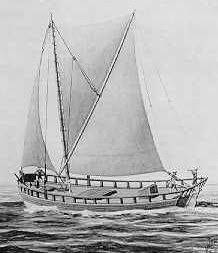
Spanish explorers used brigantines to sail along the Gulf Coast in 1543.
According to an account of the expedition, Indians knew of the future Texas’ natural seeps. “There was found a skumme, which they call Copee, which the Sea casteth up, and it is like Pitch, wherewith in some places, where Pitch is wanting, they pitch their ships; there they pitched their Brigandines.”
Learn more about the first reports of oil worldwide in Earliest Signs of Oil.
July 27, 1918 – Standard Oil of New York launches Concrete Tanker
America’s first concrete vessel designed to carry oil, the Socony, left its shipyard at Flushing Bay, New York. Built for the Standard Oil Company of New York, the barge was 98 feet long with a 32-foot beam and carried oil in six center and two wing compartments, “oil-proofed by a special process,” according to the journal Cement and Engineering News.
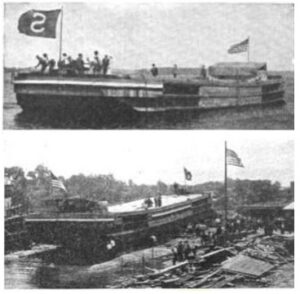
Socony, the first concrete oil tanker, launched in 1918. Below is a second version of the oil barge.
“Eight-inch cast iron pipe lines lead to each compartment and the oil pump is located on a concrete pump room aft,” the journal explained. Steel shortages during World War II would lead to the construction of larger reinforced concrete oil tankers.
_______________________
Recommended Reading: The Big Rich: The Rise and Fall of the Greatest Texas Oil Fortunes (2009); From Oklahoma to Eternity: The Life of Wiley Post and the Winnie Mae
(2009); From Oklahoma to Eternity: The Life of Wiley Post and the Winnie Mae (1998); Myth, Legend, Reality: Edwin Laurentine Drake and the Early Oil Industry
(1998); Myth, Legend, Reality: Edwin Laurentine Drake and the Early Oil Industry (2009); Western Pennsylvania’s Oil Heritage
(2009); Western Pennsylvania’s Oil Heritage (2008); Trek of the Oil Finders: A History of Exploration for Petroleum (1975); Anomalies, Pioneering Women in Petroleum Geology, 1917-2017; Breaking the Gas Ceiling: Women in the Offshore Oil and Gas Industry (2019). Your Amazon purchase benefits the American Oil & Gas Historical Society. As an Amazon Associate, AOGHS earns a commission from qualifying purchases.
(2008); Trek of the Oil Finders: A History of Exploration for Petroleum (1975); Anomalies, Pioneering Women in Petroleum Geology, 1917-2017; Breaking the Gas Ceiling: Women in the Offshore Oil and Gas Industry (2019). Your Amazon purchase benefits the American Oil & Gas Historical Society. As an Amazon Associate, AOGHS earns a commission from qualifying purchases.
_______________________
The American Oil & Gas Historical Society (AOGHS) preserves U.S. petroleum history. Please become an AOGHS annual supporter and help maintain this energy education website and expand historical research. For more information, contact bawells@aoghs.org. © 2025 Bruce A. Wells. All rights reserved.
by Bruce Wells | Jun 10, 2025 | Petroleum Transportation
North Slope oil began moving through Alaska’s 800-mile pipeline system in 1977.
The Trans-Alaska Pipeline System, designed and constructed to carry billions of barrels of North Slope oil to the port of Valdez, has been recognized as a landmark of engineering. On June 20, 1977, the 800-mile pipeline began carrying oil from Prudhoe Bay oilfields to the Port of Valdez at Prince William Sound. The oil began arriving 38 days later.
In July 1973, a tie-breaking vote by Vice President Spiro Agnew in the U.S. Senate passed the Trans-Alaska Pipeline Authorization Act after years of debate about the pipeline’s environmental impact. Concerns included spills, earthquakes, and elk migrations.
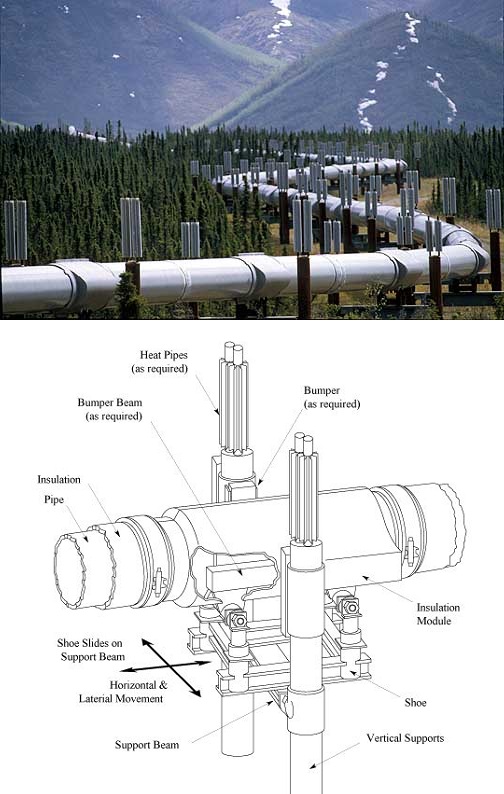
The Alaskan Pipeline system’s 420-miles above ground segments use a zig-zag configuration to allow for expansion or contraction of the pipe.
With the laying of the first section of pipe on March 27, 1975, construction began on what at the time was the largest private construction project in American history.
The 800-mile Trans-Alaska Pipeline system, including pumping stations, connecting pipelines, and the ice-free Valdez Marine Terminal, ended up costing billions. The last pipeline weld occurred on May 31, 1977, and oil from the Prudhoe Bay field began flowing to the port of Valdez on June 20, traveling at four miles an hour through the 48-inch-wide pipe.

The pipeline system cost $8 billion, including terminal and pump stations, and would transport about 20 percent of U.S. petroleum production. Tax revenue earned Alaskans about $50 billion by 2002.
Engineering Milestones
Special engineering was required to protect the environment in difficult construction conditions, according to Alyeska Pipeline Service Company. Details about the pipeline’s history include:
- Oil was first discovered in Prudhoe Bay on the North Slope in 1968.
- Alyeska Pipeline Service Company was established in 1970 to design, construct, operate and maintain the pipeline.
- The state of Alaska entered into a right-of-way agreement on May 3, 1974; the lease was renewed in November of 2002.
- Thickness of the pipeline wall: .462 inches (466 miles) & .562 inches (334 miles).
- The Trans-Alaska Pipeline System crosses the ranges of the Central Arctic heard on the North Slope and the Nelchina Herd in the Copper River Basin.
- The Valdez Terminal covers 1,000 acres and has facilities for crude oil metering, storage, transfer and loading.
- The pipeline project involved some 70,000 workers from 1969 through 1977.
- The first pipe of the Trans-Alaska Pipeline System was laid on March 27, 1975. Last weld was completed May 31, 1977.
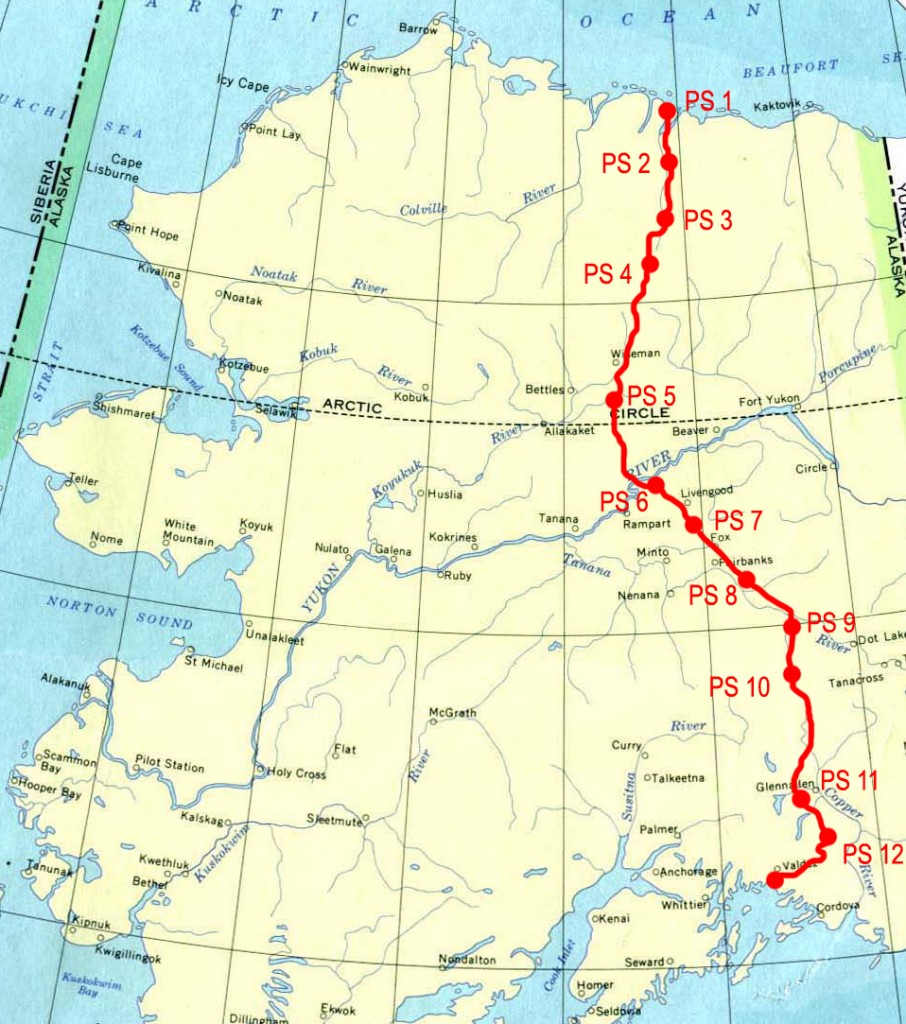
The Alaskan pipeline brings North Slope production to tankers at the port of Valdez. Map courtesy USGS.
- The pipeline is often referred to as “TAPS” – an acronym for the Trans Alaska Pipeline System.
- More than 170 bird species have been identified along the pipeline.
- First oil moved through the pipeline on June 20, 1977; it took 28 days to arrive at Valdez.

The pipeline delivered oil almost a decade after the Prudhoe Bay oilfield’s discovery. “OMAR” was the Organization for Management of Alaska’s Resources, now the Resource Development Council for Alaska.
- 71 gate valves can block the flow of oil in either direction on the pipeline.
- First tanker to carry crude oil from Valdez: ARCO Juneau, August 1, 1977.
- Maximum daily throughput was 2,145,297 on January 14, 1988.
- The pipeline is inspected and regulated by the State Pipeline Coordinator’s Office.
At the peak of its construction in the fall of 1975, more than 28,000 people worked on the pipeline. There were 31 construction camps built along the route, each built on gravel to insulate and help prevent pollution to the underlying permafrost.
Heaters
The above-ground sections of the pipeline (420 miles) were constructed in a zigzag configuration to allow for expansion or contraction of the pipe because of temperature changes.

Specially designed anchor structures, 700 feet to 1,800 feet apart, securely hold the pipe in position. In warm permafrost and other areas where heat might cause undesirable thawing, the supports contain two, two-inch pipes called “heat pipes.”

The Trans-Alaska Pipeline today has been recognized as a landmark engineering feat. It remains essential to Alaska’s economy.
The first tanker carrying North Slope oil from the new pipeline sailed out of the Valdez Marine Terminal on August 1, 1977. By 2010, the pipeline had carried about 16 billion barrels of oil. Alaska’s total oil production in 2013 was nearly 188 million barrels, or about seven percent of total U.S. production.
The first Alaska oil well with commercial production was completed in 1902 in a region where oil seeps had been known for years. The Alaska Steam Coal & Petroleum Syndicate produced the oil near the remote settlement of Katalla on Alaska’s southern coastline. The oilfield there also led to construction of Alaska Territory’s first refinery.
The modern Alaskan petroleum industry began in 1957 with an oilfield discovery at Swanson River. The next major milestone came when Atlantic Richfield (ARCO) and Exxon discovered the Prudhoe Bay field in March 1968 about 250 miles north of the Arctic Circle.
Rise and Fall of Production
The Prudhoe Bay oilfield proved to be the largest in North America at more than 213,500 acres — exceeding the “Black Giant” East Texas Oilfield discovered in 1930.

Alaska’s daily oil production peaked in 1988 at about 2 million barrels of oil per day, according to the Department of Energy Energy Information Administration (EIA), Petroleum Supply Monthly.
Annual Alaska oil production peaked in 1988 at 738 million barrels of oil — about 25 percent of U.S. oil production at the time, according to the Energy Information Administration (EIA). Production averaged about 448,000 barrels of oil per day in 2020, the lowest level in more than 40 years.
“Crude oil production in Alaska averaged 448,000 barrels per day (b/d) in 2020, the lowest level of production since 1976,” the agency noted in its April 2021 Today in Energy report. “Last year’s production was over 75 percent less than the state’s peak production of more than 2 million b/d in 1988.”

The decline in the state’s oil production has decreased deliveries in the Trans-Alaska Pipeline System, EIA added. Lower oil volumes caused oil to move more slowly in the pipeline, and the travel time from the North Shore to Valdez increased by 18 days in 2020.
For America’s pipeline history during World War II, see Big Inch Pipelines of WW II and PLUTO, Secret Pipelines of WWII.
_______________________
Recommended Reading: The Great Alaska Pipeline (1988); Amazing Pipeline Stories: How Building the Trans-Alaska Pipeline Transformed Life in America’s Last Frontier
(1988); Amazing Pipeline Stories: How Building the Trans-Alaska Pipeline Transformed Life in America’s Last Frontier (1997); Oil and Gas Pipeline Fundamentals
(1997); Oil and Gas Pipeline Fundamentals (1993); Oil: From Prospect to Pipeline
(1993); Oil: From Prospect to Pipeline (1971). Your Amazon purchase benefits the American Oil & Gas Historical Society. As an Amazon Associate, AOGHS earns a commission from qualifying purchases.
(1971). Your Amazon purchase benefits the American Oil & Gas Historical Society. As an Amazon Associate, AOGHS earns a commission from qualifying purchases.
_______________________
The American Oil & Gas Historical Society (AOGHS) preserves U.S. petroleum history. Please become an AOGHS annual supporter and help maintain this energy education website and expand historical research. For more information, contact bawells@aoghs.org. © 2025 Bruce A. Wells.
Citation Information – Article Title: “Trans-Alaska Pipeline History.” Author: Aoghs.org Editors. Website Name: American Oil & Gas Historical Society. URL: https://aoghs.org/transportation/trans-alaska-pipeline. Last Updated: July 14, 2025. Original Published Date: June 20, 2015.






(1986); Trek of the Oil Finders: A History of Exploration for Petroleum (1975); Amazing Pipeline Stories: How Building the Trans-Alaska Pipeline Transformed Life in America’s Last Frontier
(1997). Early Texas Oil: A Photographic History, 1866-1936
(2000); Eisenhower: Soldier and President
(1968); The Extraction State, A History of Natural Gas in America (2021); Torpedoes in the Gulf: Galveston and the U-Boats, 1942-1943
(1995). The Big Roads: The Untold Story of the Engineers, Visionaries, and Trailblazers Who Created the American Superhighways
(2012); Monsters Of Old Los Angeles – The Prehistoric Animals Of The La Brea Tar Pits
(2008); Oil: From Prospect to Pipeline
(1971). Amazon purchases benefit the American Oil & Gas Historical Society. As an Amazon Associate, AOGHS earns a commission from qualifying purchases.

















